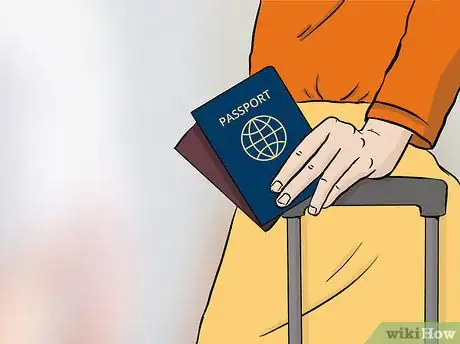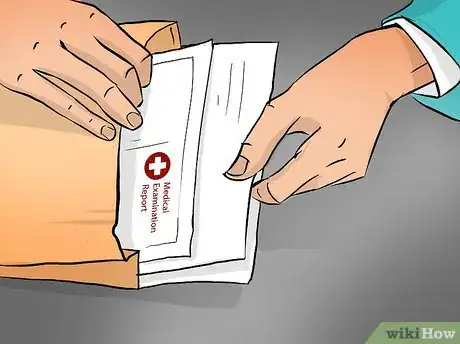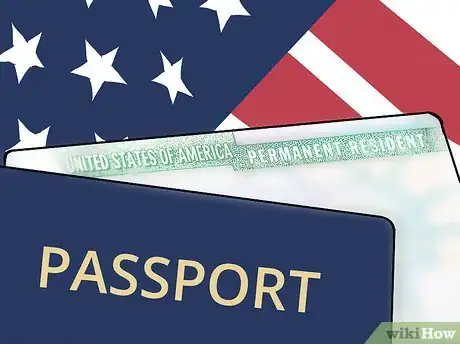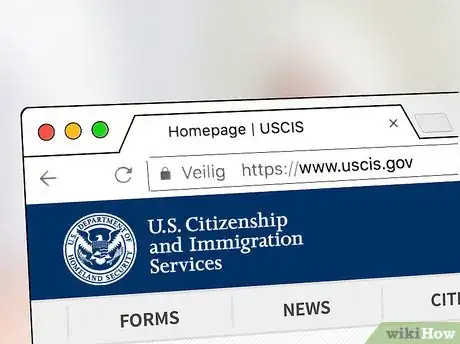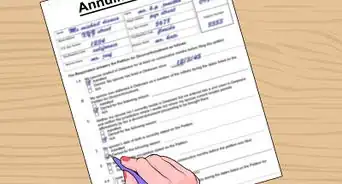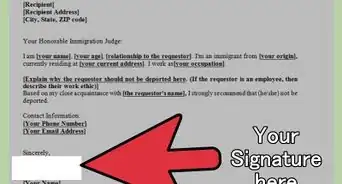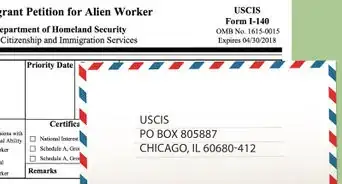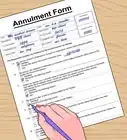This article was written by David Katona and by wikiHow staff writer, Jennifer Mueller, JD. David Katona is an Immigration Lawyer and the Founder of Katona & Associates PLLC in New York City. With over 20 years of experience, he specializes in business immigration and green card sponsorship. He earned a law degree from American University Washington College of Law, a Master of International Affairs from American University’s School of International Service, and a BS in Business from Wake Forest University. Super Lawyers named him a Super Lawyer - Business Immigration in 2014, 2016-2022, and a Rising Star - Business Immigration in 2011. His firm was also rated by Best Lawyers as a Tier 1 immigration firm in NYC and Tier 2 nationally from 2020-2023. David is a member of the American Immigration Lawyers Association (AILA) and the NYC Bar Association.
There are 14 references cited in this article, which can be found at the bottom of the page.
wikiHow marks an article as reader-approved once it receives enough positive feedback. This article received 24 testimonials and 91% of readers who voted found it helpful, earning it our reader-approved status.
This article has been viewed 593,991 times.
As of 2018, there are more than 44 million immigrants living in the United States.[1] If you are currently outside the US, your path begins by applying for an immigrant visa and become a permanent resident. On the other hand, if you are already in the US, you can apply for permanent resident status through the "adjustment of status" process.[2] After living in the US as a permanent resident for 5 years or longer, you may be eligible to become a naturalized citizen.[3]
Steps
Applying for an Immigrant Visa
-
1Identify the appropriate category for your visa. If you are currently outside the US and want to immigrate into the US permanently, you must first acquire an immigrant visa. There are several categories of immigrant visa, each of which requires a different application form and supporting documentation.[4]
- The US prioritizes immigrant visas based on categories. The highest priority is given to immigrants who already have family in the US who are either US citizens or permanent residents. The next highest priority is given to immigrants who already have employment in the US.
- You can apply for a visa in other categories, such as an asylum visa. These visas are extremely limited. The number of available visas may be further limited depending on your current country. The wait list for a visa in these categories can sometimes be years long.
-
2Choose someone to sponsor your visa application. If you want to apply for an immigrant visa, you need a US citizen to sponsor you. If you're applying under the family visa category, that person will be a family member of yours who is a US citizen. For the employment-based category, your sponsor will typically be your prospective employer.
- If you are being sponsored by a family member, they must be a US citizen over 18 years of age.
- If the person sponsoring you has never sponsored an immigrant before, the two of you may need to take some time to read through the process and understand what's involved. An attorney who specializes in immigration law can help walk you through it. There are also nonprofit organizations that help immigrants.
Advertisement -
3Have your sponsor submit a petition on your behalf. The required forms your sponsor must complete and file are available for download from the US Citizenship and Immigration Services (USCIS) website. The forms include instructions for completing them and submitting them to USCIS.[5]
- If you are being sponsored by a family member, they will file Form I-130, Petition for Alien Relative. If you are being sponsored by a prospective employer, they will file Form I-140, Petition for Alien Worker.
-
4Wait for notification from the National Visa Center (NVC). If your petition is approved, USCIS will send it to the NVC for processing. The NVC collects your visa application, fees, and supporting documentation. Because there are a limited number of visas available each year in each category, it may be months or even years before you hear from the NVC.[6]
- The NVC notification includes instructions on the next steps to apply for an immigration visa. Read these instructions carefully and get assistance from an immigration lawyer or nonprofit agency if you don't understand them. Not following the instructions could delay the processing of your application, or result in your application being rejected.
- At this time, you can choose an agent to receive NVC communications on your behalf. This may be necessary if you move frequently, or do not have a stable permanent address. You can also serve as your own agent.
Tip: It's not a bad idea to start gathering your supporting documents while you're waiting for notification from the NVC. The visa application and instructions are available on the USCIS website.
-
5Submit your application, fees, and documents to the NVC. The application for an immigration visa is detailed and relatively lengthy. Most of the information you provide on your application must be supported with official documentation. When you've completed your application and gathered the required documents, send the entire package to the NVC.[7]
- It's a good idea to go through your application and documentation with an immigration lawyer before you submit it. You must pay fees of more than US$1,000. If your application is denied you won't get any of that money back, and you'll have to start the process all over again.
- In some countries, you'll use the Consular Electronic Application Center (CEAC) to submit your application, fees, and documents, rather than mailing them. This process is more secure and saves time.
-
6Have a medical examination. The USCIS requires a medical examination to determine whether you are a threat to public health. You will receive any required vaccinations and be screened for any communicable diseases.[8]
- The doctor must complete Form I-693, which they will seal in an envelope. Do not take the form out of the envelope. You must deliver it to the consular office in a sealed envelope on the day of your interview.
- This medical examination is valid 6 months.
-
7Attend your interview with a consular officer. Your interview will typically take place at the US embassy or consulate nearest where you live in your home country.[9]
- During the interview, the officer will review your supporting documents and ask you questions about your application.
- If you are applying with a family member, typically they must attend the interview with you.
- You will find out at the end of the interview if your visa has been approved. If the consular officer needs additional documents or information before they can approve your visa, they'll let you know. Get those documents to them as soon as possible.
- The consular officer may deny your visa application. There usually is no appeal from a denial. You may be able to get your application reconsidered by another officer. This may require an additional interview.
-
8Travel to the US with your immigrant visa. Within a few days of your interview, your immigrant visa will be available. You can pick it up at the embassy or consular office along with your passport. You are expected to travel to the US before the visa expires, which is usually 6 months (your medical examination is valid 6 months, so keep that in mind as well).[10]
- You will also receive a sealed packet of documents to present to US customs officials at the port of entry. Do not open this sealed packet.
Applying for a Green Card
-
1Find out if you're eligible for a Green Card. If you're in the US on a non-immigrant visa and want to become a permanent resident, you can apply for an "adjustment of status" if you fall within one of the available categories. Permanent residency is most commonly available for people who have a family relative who is a US citizen, or for people who have stable full-time employment in the US.[11]
- For example, if you came to the US on a student visa and were later hired as a professor by your university, you could apply for an employment-based Green Card with the university as a sponsor.
- Green Cards are also issued to people here on a non-immigrant visa who fall in love with someone while in the US and decide to get married.
- All available categories are listed on the USCIS website. It's also a good idea to talk to an immigration attorney before you begin the application process. They can give you some advice and help you navigate the process.
Tip: While the most common reasons for an adjustment of status are family- or employment-based, you can also get a Green Card for other reasons. However, there are a limited number of adjustments made for other reasons each year. The USCIS will not accept your application if there are no adjustments currently available for that reason. You can check the availability on the USCIS website.
-
2Complete an application for permanent residency. If you're applying for a Green Card from within the US, you need to fill out Form I-485, Application to Register Permanent Residence or Adjust Status. The form asks questions about you, your reasons for seeking permanent residency, and your educational, work, and criminal history.[12]
- You can download a copy of the application, and instructions for filling it out, at https://www.uscis.gov/i-485.
-
3Gather documents to support your application. Nearly all statements that you make on your application for permanent residency must be backed up with official documents. The specific documents you'll need depend on your application category.[13]
- If you married a US citizen and are seeking an adjustment of status on that basis, you would need to provide a certified copy of your marriage certificate.
- If you're seeking an adjustment of status because you have a full-time job in the US, you would need documents proving your employment. Typically this includes a letter from your manager or supervisor verifying your employment.
- Regardless of the category of your application, you'll need financial documents, including copies of your most recent tax return.
-
4File your application with USCIS. When you've completed your application and gathered all the required documents, mail them to a USCIS lockbox for processing, along with your application fee. It's a good idea to make a copy of everything you send for your own records before you mail it off.[14]
- The address where you send your application and supporting documents depends on your eligibility category. Find the appropriate address at https://www.uscis.gov/i-485-addresses.
-
5Go to your biometrics services appointment. USCIS uses biometrics to verify your identity. When your application is received, USCIS will send you a notice with the date, time, and location of your appointment. Biometrics appointments are scheduled at an Application Support Center (ASC) near you.[15]
- During this appointment, you will be fingerprinted and photographed. You will also be asked to sign an acknowledgment certifying that all the information on your application is complete and correct to the best of your knowledge.
-
6Attend your interview with USCIS if necessary. In many cases, a USCIS interview isn't necessary for an adjustment of status – particularly if you've had a visa interview recently for a non-immigrant visa. [16]
- During the interview, a USCIS agent will ask you questions about your application and your reasons for applying for permanent residency. Answer their questions completely and honestly. If you don't understand something or don't know the answer, let them know so they can clarify or give you time to find an accurate answer.
- If you're applying for permanent residency because you married a US citizen, your spouse typically must attend the interview as well. The USCIS agent may interview each of you separately.
-
7Receive a decision on your application. Typically, USCIS will send you a written notice of the decision first. If your application was approved, you'll get your actual Green Card a few weeks after you receive the decision notice.[17]
- If your application was denied, the notice will tell you the reasons for denial and whether you can appeal the decision. Most reasons for denial do not allow for an appeal. However, you may be able to file a motion for reconsideration (to have your application reconsidered by a different USCIS agent), or a motion to reopen your case (if you want to submit additional supporting documents or information).
Becoming a US Citizen
-
1Live in the US as a lawful permanent resident. Before you are eligible to become a US citizen, you must live in the country as a permanent resident for 5 years. This period is reduced to 3 years if you are married to a US citizen or for other special circumstances such as military service.[18]
- Your residency must also be continuous, or the time starts over. While it's okay to take brief trips out of the country, at least 30 months of continuous residency in the US is typically required.
- While you're a permanent resident, take care to follow all applicable laws and local ordinances. Any infractions could make it more difficult for you to become a citizen.
-
2Complete an application for naturalization. After you've lived in the US for the requisite period of time, you can apply to become a citizen of the US. The application, Form N-400, is available on the USCIS website.[19]
- As a Green Card holder, you are entitled to live in the US permanently. However, if you become a naturalized citizen, you have the right to vote and receive benefits, such as Social Security, from the federal government.
- Fill out the application completely and accurately. Be honest in your answers, even if you think the truth might hurt your chances of becoming a citizen.
- Before you begin the application process, the USCIS recommends you read the Guide to Naturalization. You can download the guide at https://www.uscis.gov/sites/default/files/files/article/M-476.pdf.
-
3Submit your application to USCIS. Once you've completed your application and compiled any necessary supporting documents, mail it to the appropriate USCIS lockbox facility along with the fees for processing.[20]
- The Guide to Naturalization provides the addresses for the lockbox facilities. Generally, the address you use depends on where in the US or its territories you currently live.
-
4Attend a citizenship interview with a USCIS agent. After your application is processed, you'll receive a notice of the date, time, and location of your interview. The interview typically covers questions about your application, as well as your background, your character, and your attachment and loyalty to the US and the US Constitution.[21]
- While you are taking your interview, you are considered to be under oath. If the USCIS agent catches you lying about anything, they will terminate your interview immediately and reject your application.
Tip: If your application is rejected, you'll receive a notice explaining the reasons. You have the right to appeal a rejection by requesting a hearing with an immigration officer. If the immigration officer doesn't approve your application, you can appeal your case to a US District Court. All of these appeals will cost you additional fees, plus potential court costs. If you decide to appeal, contact an immigration attorney to discuss your options.
-
5Take the US citizenship test. The citizenship test consists of an English test and a civics test. For the English portion of the test, you must be able to read, write, and answer questions in English. The civics test consists of 10 questions about the US government and history. You must answer at least 6 of the 10 questions correctly.[22]
- There are 100 possible civics questions you may be asked. You can download a copy of these questions from the USCIS website if you want to study.
- You can also take a preparation course or use a study guide. These resources are available for free at most public libraries. Universities and nonprofit organizations near you may also offer resources free of charge to help you prepare for the test.
-
6Attend your naturalization ceremony. If you pass the citizenship test, you will be invited to attend a naturalization ceremony and take the Oath of Allegiance. You are not considered an official US citizenship until you've taken the Oath.[23]
- The naturalization ceremony is a significant occasion for most new citizens. However, if for some reason you are unable to attend, you have other options for taking the Oath. You can even take the Oath at the end of your test if you choose.
Warnings
- Your Green Card must be renewed every 10 years, or every 2 years if you are given a conditional Green Card. Visit the USCIS website to start the renewal process at least 6 months before it expires, to allow time for your application to be reviewed.[24]⧼thumbs_response⧽
References
- ↑ https://www.migrationpolicy.org/article/frequently-requested-statistics-immigrants-and-immigration-united-states
- ↑ https://www.usa.gov/enter-us
- ↑ https://www.uscis.gov/sites/default/files/files/article/M-476.pdf
- ↑ https://travel.state.gov/content/travel/en/us-visas/immigrate/the-immigrant-visa-process.html
- ↑ https://travel.state.gov/content/travel/en/us-visas/immigrate/the-immigrant-visa-process.html
- ↑ https://travel.state.gov/content/travel/en/us-visas/immigrate/the-immigrant-visa-process/after-petition-approved.html
- ↑ https://travel.state.gov/content/travel/en/us-visas/immigrate/the-immigrant-visa-process/collect-and-submit-forms-and-documents-to-the-nvc.html
- ↑ https://travel.state.gov/content/travel/en/us-visas/immigrate/the-immigrant-visa-process/interview/interview-prepare.html
- ↑ https://travel.state.gov/content/travel/en/us-visas/immigrate/the-immigrant-visa-process/interview/applicant-interview.html
- ↑ https://travel.state.gov/content/travel/en/us-visas/immigrate/the-immigrant-visa-process/interview/after-the-interview.html
- ↑ https://www.uscis.gov/greencard/eligibility-categories
- ↑ https://www.usa.gov/green-cards
- ↑ https://isss.wvu.edu/files/d/c2dbf9ae-fed0-4e57-84e6-f845724d652a/aos-checklist-2-17-2017.pdf
- ↑ https://www.usa.gov/green-cards
- ↑ https://www.uscis.gov/greencard/adjustment-of-status
- ↑ https://www.uscis.gov/greencard/adjustment-of-status
- ↑ https://www.uscis.gov/greencard/adjustment-of-status
- ↑ https://www.uscis.gov/sites/default/files/files/article/M-476.pdf
- ↑ https://www.uscis.gov/sites/default/files/files/article/M-476.pdf
- ↑ https://www.uscis.gov/sites/default/files/files/article/M-476.pdf
- ↑ https://www.uscis.gov/sites/default/files/files/article/M-476.pdf
- ↑ https://www.uscis.gov/sites/default/files/files/article/M-476.pdf
- ↑ https://www.uscis.gov/sites/default/files/files/article/M-476.pdf
- ↑ https://www.uscis.gov/green-card/after-green-card-granted
About This Article
To immigrate to the United States permanently, first you'll need to apply for an immigrant visa and find a US citizen to sponsor your application. Keep in mind that it can take months or years to get approved depending on the category of immigrant visa you're eligible for. Then, once you're living in the US, you can apply for a green card to get permanent resident status. If you want to become a US citizen, you must live in the US for 5 years and take a citizenship test. To learn how to apply for a US green card, scroll down!







